*[CLICK ON THE PICTURES TO GET A CLEARER & BIGGER VERSION :)]
Breezy winds - checked!
Sunshiny weather - checked!
Camera - checked!
And we are all set for my first field trip of the Biodiversity module! Last semester, I have always been envious of my friend who got to take their lecture theater outdoors while I had to endure the goosebumps-raising chill of my other 2 core modules. But the tables have turned, and I shall savour every moment spent, even if it means having to walk along the Kent Ridge pathway under a drizzling patter.
The location - NUS Kent Ridge Campus Forest Area is in fact, just behind from where I currently stay, King Edward 7 Hall. However, let's not get all excited at the mention of the word forest, for this vegetation type falls under secondary forest. Meaning, it was once a primary forest, but then it got chopped, razed, and butchered to its roots until nothing was left. But that was till the shrubs and other non-woody plants colonized the area followed by emergence of Adinandra species, and that's when a secondary forest slowly made its debut. And for that, this secondary forest is called the Adinandra belukar. It's like a tip of the hat to one of the most dominant species growing on this degraded soil - Adinandra dumosa. =)
However, it's difficult for this forest to regain its former primary forest glory due to 3 reasons: -
1) The highly acidic and nutrient-poor soils are a big no-no for the sustainability and the survival of primary forest species.
2) There's too much disturbance going on in the secondary forest. In fact, the disturbance that occurs (or the lack thereof) is one of the characteristics that's used to differentiate a secondary vegetation type from a primary one.
3) The nearest seed source for primary forest species is still too far away to allow easy transfer, unless the seed dispersal is done by us Homo sapiens.
From this practical, out of the 240 species of vascular plants, we need to recognise at least 10 species of flora.
Checklist: (Plants)
1. Simpoh Air (Dillenia suffruticosa)
2. Sendudok (Melastoma malabathricum)
3. Resam (Dicranopteris linearis)
4. Tiup Tiup (Adinandra dumosa)
5. Sarsaparilla vine (Smilax setosa)
6. Figs (Ficus sp.)
7. Rubber tree (Hevea brasiliensis)
8. Orange Felt (Trentepholia sp.)
9. Lichens
10. Acacia (Acacia auriculiformis)
11. Fishtail palm (Caryota mitis)
12. Hairy Clidemia @ Koster's Curse (Clidemia hirta)
13. Dragon's scales (Pyrrosia piloselloides)
14. Riccia (thalloid liverwort)
15. Cycads
We basically saw most of everything except for number 14 and 15. Despite the rain, we still had a real treat. And ‘it’ was the most adorable thing ever. ^^ (Continue reading to find out more about ‘it’)
1. Simpoh Air (Dillenia suffruticosa)
The Simpoh Air is one of the most common plants around. But even so, the flowers are really unique and pretty. It's unfortunate that we were unable to see any of the yellow flowers nor its crimson pinkish fruits. (edit) 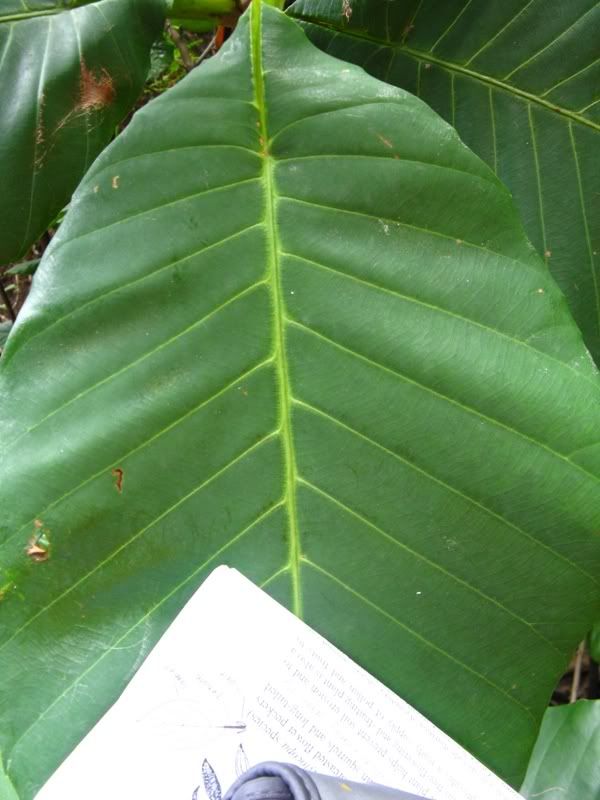 ___
___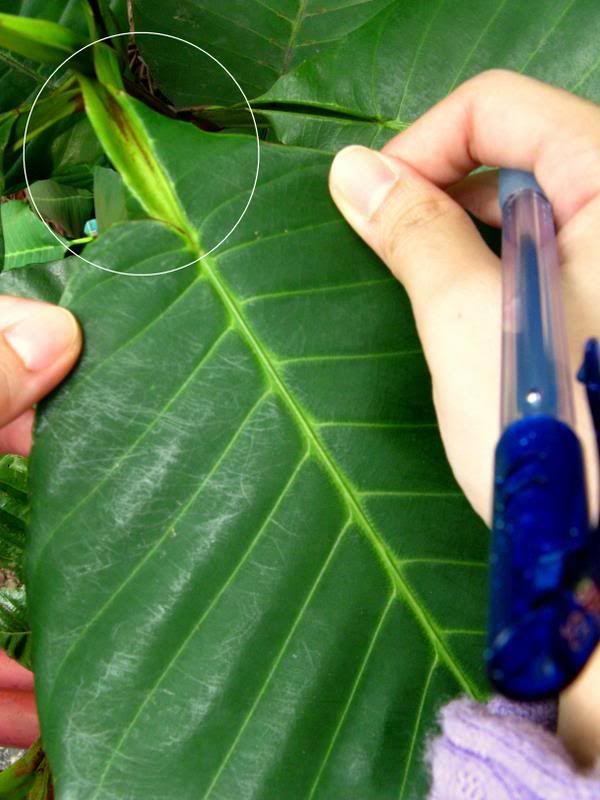
Generally, the leaves of this plant is rather huge in size. In fact, these large leaf blades have been used to wrap food such as “chee cheong fan”, rojak or tempeh. Interestingly, this plant has a rather.. ermm, how do you put it, a unique local name. It's also known to some as the CB plant since the slit at the top (right) resembles a female's nether regions. What do you think? -.- But aside from that, this plant is a keystone (or in layman terms, influential) species of the adinandra belukar as the species blooms and fruits throughout the year. Hence, it's a steady source of food for both the birds and the bees.
Status: Native
2. Sendudok (Melastoma malabathricum) 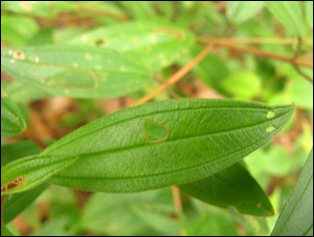 __
__
(left): One distinctive nature of this plant is that this leaf has 3 prominent longitudinal veins that run down the blades and converge at its leafstalk base. Apparently, eating the pulp blackens the lining of the mouth and tongue, hence the name ‘Melastoma'.
mela (= black)
stoma (= mouth)
(right): Though this flower wasn’t taken at Kent Ridge, it doesn’t matter much for they look pretty much the same everywhere. =) But there are some rare occasions where Nature decides to throw caution in the wind. Instead of the usual 5 purplish-pink petals, they will be in white. Against the purple background, lies a cluster of light-purple and yellow stamens (male) surrounding the lone, long pistil (female).
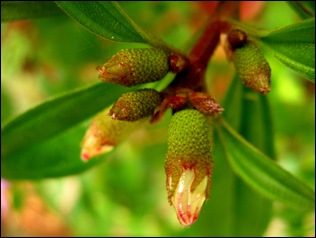 ___
___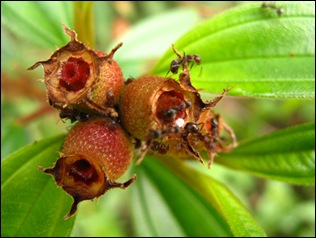
(left): The unripe fruits of the Sendudok. The tip reminds me of the flesh of a pomelo though. [Shot this picture along the road that led from Ang Mo Kio to Bukit Timah Expressway (BKE)]. Another first!
(right): Typically, the fruits that I usually see after fertilization is as such. It bulges and turns rather oval in shape. The dark purple, inner pulp must be really sweet, or ants wouldn’t be swarming over this particular cluster.
Status: Native
3. Resam (Dicranopteris linearis) 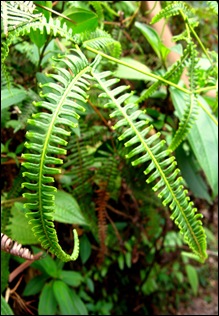 __
__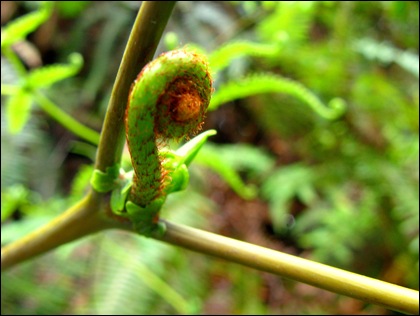
(left): The resam is a fern that is a pioneer of areas that have been torched. In just a short time, it can cover an open area which in turn, prevents the growth of other plants and might even cause inhibition (by trapping the seeds dispersed by the birds and the bees). However, fret not if you worry that this species will lord over the rest. It’s eventually shaded out as the spot will be succeeded by tall trees in a natural forest succession.
(right): The adorable fiddle head of the fern, which is just simply the curled-up young frond, ferns in particular. These guys proliferate via the dispersal of spores. When it hits maturity, the sori (= clusters of spore-containing sacs) at the underside of the adult frond dries up and turns brown and brittle. Without a need for much force, the sporangia (= spore-containing sacs) can be easily broken and then be dispersed by wind. Of course, too much of the spores in the air can cause allergic reactions for some people that are sensitive to them.
Status: Native
4. Tiup Tiup (Adinandra dumosa) 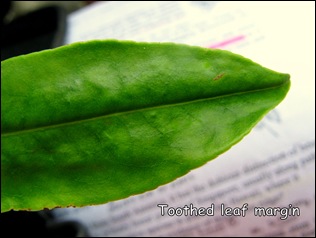 __
__ 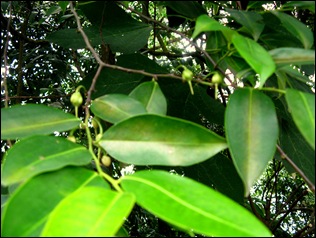
(left): And this is the tree which the belukar is named after: the Adinandra dumosa. Why? That’s because this one of the dominant species in this particular forest harboring nutrient-poor, acidic soil. One way to recognize this species is to check out the leaf margin, which is slightly toothed. Of course, there are other ways to tell this plant apart -
--> leaves: simple and grow in alternates. Juveniles are leathery, elliptical and reddish when young while the mature ones are dark green and withering dark scarlet.
As a keystone species (since it flowers and fruits all year round), this plant is an important baseline supplier of pollen and fruits for bees and bats respectively.
(right): Seen here are the unripe fruits of the tiup-tiup. The protrusion that can be seen fairly clearly from this picture is the pistil (prominent in both the flower and the fruit). The berries soon turn from green to brown, and then hang downwards on slender stalks.
Status: Native
5. Sarsaparilla vine (Smilax setosa) 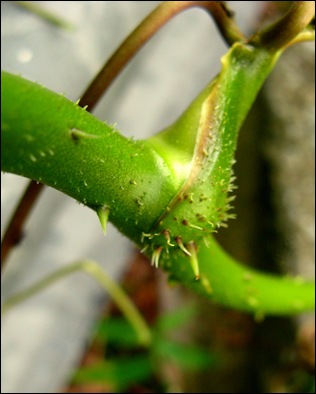 ___
___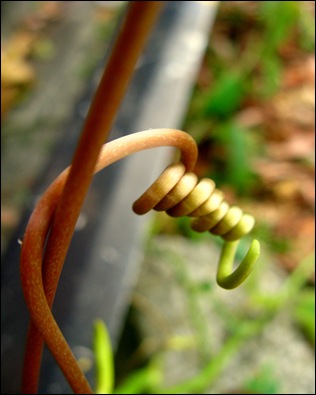
(left): Be careful when handling the Smilax for their stem is covered with and abundance of prickles. This portion of the plant is probably a young one for the prickles are greener while the mature ones are (the ones I usually catch sight of) long and a formidable red. Trust me, one look and you will know this is one plant that doesn’t give up easily. (I will be posting that up in a later entry) :)
(right): The long, twining stem of the vine which is used to attach to supporting structures like the branches of a tree.
 _
_ 
(left): There are some tips of the Smilax which we noticed, were rather peculiar in shape. According to our Teaching Assistant (TA), drip tips are used to drain water efficiently of a leaf, and hence, to increase the drying of the leaf. In fact, studies have found that these modified forms may be an adaption to avoid colonization by fungi, though it may not be much against the growth of mosses and lichens on leaves.
(right): One way to recognize this plant is to note the 3 main veins that run longitudinally across the leaf blades. Based on what I understood from the practical, the 3 main veins are as depicted in the picture. [1]
Status: Native
6. White-leafed fig (Ficus grossularoides) 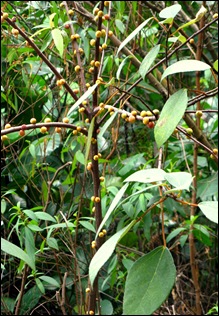 _
_ 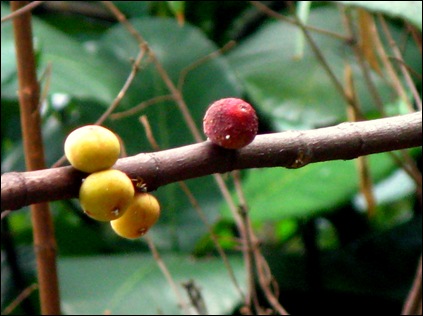
(left): Being part of the genus with more than 800 species, the white-leafed fig is one of the most commonly seen species at Kent Ridge. It’s so called because the underside of the leaf is pale shade of whitish-green. See those ‘fruits’ that seem to be growing on every branch, twig and the trunk?
(right): These hollow, and fleshy ‘fruits’ are actually none other than the flowers or more specifically the syconia (syconium, singular) of the fig plants. In reality, each is a rather complex inflorescence (= cluster of flowers) which house both male and female flowers. (Actually, to call a flower male or female is rather inaccurate, but for simplicity, I will just stick to it ^_^). And interestingly, it’s one species of wasp for the pollination of one species of fig. Apparently, this reduces competition with other species of wasp. But, the downside remains. It’s sayonara to that particular fig if its specific pollinator goes extinct. >__>[2]
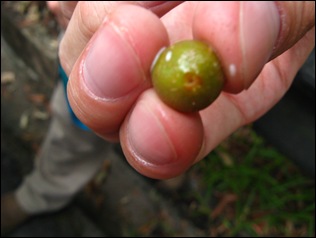 __
__ 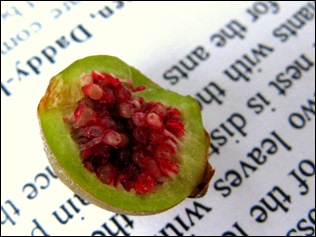
(left): The process kicks off with a female fig wasp worming her way through a syconium via a very small, tight opening known as the ostiole. She suffers injuries (though mortality might not be incurred) during the struggle, sometimes losing wings and even appendages. [2]
(right): Once inside, she lays a single egg inside each flower (the red beady-like forms) using a tube called an ovipositor. The female usually knocks on Death’s door after laying all her eggs (talk about being committed till the final breath), often from the injuries sustained during the process of entering the syconium. Sad but that’s reality. Nothing’s ever fair. In fact, the wingless males never even get to see the light of day. After hatching, they meet their demise after mating with their female siblings. >_< [2]
Status: Native
7. Rubber tree (Hevea brasiliensis) 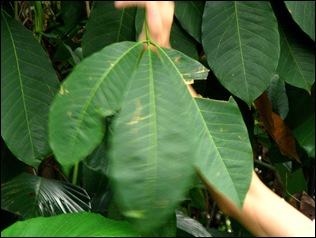 __
__ 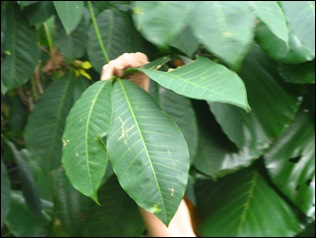
Notice a plant with trifoliate leaves (tri = 3; foliate= leaves)? Then, there’s a high possibility that the plant might be a rubber tree. This plant is cultivated for its white latex, which is collected in plantations by tapping the trunk daily for the processing of rubber sheets. 100 years back, the NUS campus was, in fact, a rubber plantation! And as indicated by its species name, it can be easily deduced where the plant originated from. =)
Status: Non-native (Brazil)
8. Orange Felt (Trentepholia sp.) & 9. Lichens  __
__ 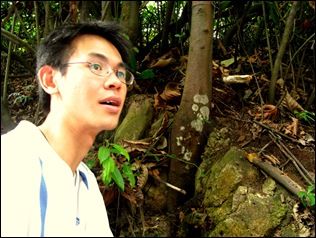
(left): According to my practical guide for students, the orange felt is actually green, terrestrial alga with a lot of carotene pigments. Whether it’s on tree trunks or building walls, these alga can be found just anywhere, which many find is a sight for sore eyes. Nippon paint has even formulated a special paint to halt the growth of this particular alga (other algae and fungi included too).
(right): And just behind my TA are patches of lichen on the tree trunk. Lichens aren’t actually 1 organism, but 2!! It’s a combination of –>
lichen = fungal filaments (basidiomycetes or ascomycetes) + algal cells (either green/blue bacteria group) Without the algal cells, the fungal filaments cannot survive as the former provides nutrients via photosynthesis. On the other hand, the algal cells can survive, with or without the fungal filaments.
Highlight of the day: Slender Pitcher Plant (Nepenthes gracilis) [edit] 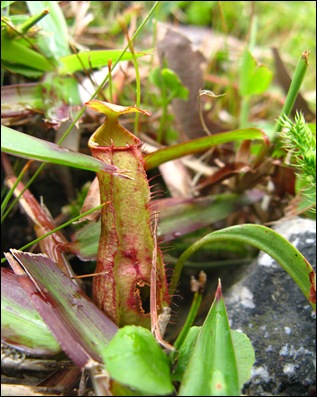 __
__ 
It can’t be denied but to vote this as the highlight of my Kent Ridge field trip practical. Not that I have never seen a pitcher plant before, but to actually see one (about 1cm high) growing on campus grounds was really an amazing experience. The slender pitcher plants are rather charismatic and because of so, they have been poached near to extinction at all accessible sites in Singapore. Found growing close to the ground, one can easily miss it if the eyes are sharp enough. The pitcher is actually a well-developed leaf tip that the plant uses to capture crawling insects like ants. [2] Check out the picture on the right and see how many pitcher plants you can spot besides the one that’s smacked directly in the middle. =)
**Thanks AY & HW, for the pointing out the errors! =)
References:
1. http://seedsaside.wordpress.com/2008/05/10/drip-tips-drain-leaves-more-efficiently/
2. Tan et. al. (2006) The Natural Heritage of Singapore, 2nd edition.

that is gracilis lar.... not ampullaria....
ReplyDeletegracilist is slender... this is just a young plant.
ampullaria is FAT!!! just like alex
Hi, which part of the forest did u find nepenthes?
ReplyDelete